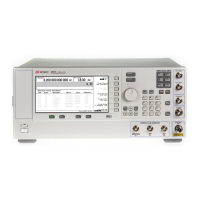E8257D/67D, E8663D PSG Signal Generators Service Guide
Troubleshooting
RF Path Description (Frequency Generation, Level Control, and Modulation)
1-102
A35 3–20 GHz I/Q Modulator (Vector Models Only)
The A35 3–20 GHz I/Q Modulator adds I/Q information to the RF signal. In 20 GHz models, the A35 3–20 GHz I/Q
Modulator is installed between the A28 20 GHz Doubler and the A30 Mod Filter. In models with output frequencies
above 20 GHz, the A35 3–20 GHz I/Q Modulator is installed after the A28 20 GHz Doubler with one output
(11.4–19 GHz) routed to the A27 40 GHz Doubler and the other output routed to the A37 Upconverter. The
A35 3–20 GHz I/Q Modulator provides the 90° delay circuitry required for I/Q modulation. The I and Q inputs to the
A35 3–20 GHz I/Q Modulator are from the A13 I/Q Multiplexer. The A13 I/Q Multiplexer receives inputs from the
External I/Q Mod inputs and, if installed, the Option 601/602 Baseband Generator.
A36 Quadraplier (Analog Models > 40 GHz)
The A36 Quadraplier is installed after the A25 20 GHz Modulator and before the A24 High Band Detector Coupler. The
A36 Quadraplier provides an input to a through path for signals from 250 kHz to 20 GHz and an input a doubler path
for frequencies >20 GHz. The doubler path contains 2 doublers, on to generator frequencies up to 40 GHz, and a
second to generate frequencies above 40 GHz. For frequencies > 20 GHz to ≤ 40 GHz, the doubler output is switched
to a path containing ALC and pulse modulation circuitry and then to the A36 Quadraplier’s output. For frequencies
> 40 GHz, the 20 to 40 GHz doubler output is switched to the second doubler and another ALC and pulse modulation
control circuit before going to the A36 Quadraplier’s output.
Two prelevel detectors in the A36 Quadraplier provide feedback to the A30 Modulation Filter/ALC modulator to
control the power into the A36 Quadraplier. One pre–level detector is located in the 20 GHz to 40 GHz path, and the
other is located in the > 40 GHz path. The ALC modulator drive signal from the A10 ALC board is routed to the
A36 Quadraplier to control the power level and provide AM modulation. Depending on the frequency, the ALC
modulation drive is switched to the A30 Modulation Filter, the A36 Quadraplier’s 20 to 40 GHz path, or the
A36 Quadraplier > 40 GHz path.
A37 44 GHz Upconverter (Vector Models > 20 GHz)
The A37 Upconverter’s main function is to be a mixer and to generate frequencies > 20 GHz. For frequencies less than
20 GHz, the A35 3–20 GHz I/Q Modulator output is routed through the A37 Upconverter to the A30 3–20 GHz
Modulation Filter, then through the upconverter to it’s output.
For frequencies > 20 GHz, the output of the A35 3–20 GHz IQ Modulator is routed to the A37 Upconverter and
switched to the IF (IQ) input of the mixer. The 40 GHz Doubler output is routed to the A37 Upconverter and
connected to the LO input of the mixer. The upconverter’s mixer LO frequency is always four times the IF frequency.
The desired RF output signal from the mixer will be either the sum frequency (LO+IF) or the difference frequency
(LO–IF). For frequencies between 20 an 28.5 GHz the difference frequency is used. Without correction the difference
frequency mixing products will invert IQ, FM, and phase modulation. For example, an increasing frequency FM mixer
input signal will produce a decreasing frequency FM mixer output signal. When operating in the > 20 GHz and
<
28.5 GHz frequency range, the PSG automatically corrects internal and external IQ, FM, and phase modulation
signals. However, the PSG does not correct I and Q input signals from the rear panel for Option 015 (Wideband IQ)
inputs. To maintain the correct phase relationships in this frequency band, the I and Q wideband inputs at the signal
generator’s rear panel must be reversed.
NOTE Instruments with Option 015 route the rear panel wideband IQ inputs directly to the IQ modulator. Swap the
I and Q signals when using the rear panel wideband IQ inputs at RF > 20 GHz and < 28.5 GHz.

